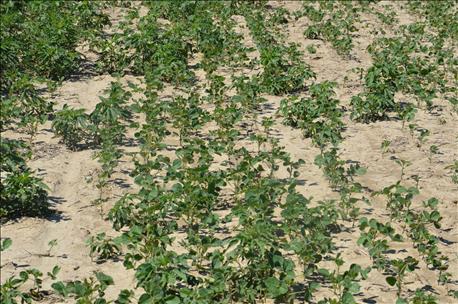
More than three-fourths of the farmers who will be recognized as Farmers of the Day at the Indiana State Fair this year have tried cover crops, and almost all of them still use the practice. Some who haven’t tried cover crops are thinking about it.
If someone uses cover crops, they likely lean toward reduced tillage. The 75% or more of the Indiana State Fair 2016 Featured Farmers do at least some no-till. For some, it’s their only tillage system. The Farmer of the Day program is co-sponsored by Dow AgroSciences.

GROWING IN CONCRETE: If you don’t feel sorry for these poor soybeans, you should. They are attempting to grow in soil so hard, it’s like concrete.
So is soil health just a catch phrase — a fad? My intuition says no. It will likely become a trend, if it hasn’t reached that status already. And that's because it works. Fields where no-till and/or cover crops are used consistently tend to be more productive. You can see it in the crops that grow there, and in the yields that farmers report hauling off those fields.
I learned one thing for sure on a trip across Indiana earlier this summer. Despite all the talk about no-till and what it can do for soil health, not everyone has received the message. Some fields still show signs of soil compaction, often with alternating taller and shorter corn, or yellowish corn vs. green corn in patterns. Soil compaction in drier weather really brings those issues to light. If soil compaction is that prevalent, it’s unlikely the soil is full of earthworms and other beneficial biological activity.
However, one field I ran across could be the poster child for the soil health concept. A neighbor knew it had been in soybeans for a long time, without rotation to corn, but he wasn’t sure how long. He couldn’t remember ever seeing it in corn.
One look at the soil on a hot, late-June afternoon, and it brought back memories. Back before we knew any better in the late 1970s, when my father farmed and I helped, Crosby soils — the light gray soils in between dark soils and reddish clay hills — used to form a crust as thick as concrete in fields where we did a lot of tillage.
The memory came back because this field looked just like that. It looked like someone had poured concrete in the field. Small, struggling soybeans were attempting to grow, having emerged but still smaller than they should have been, compared to other fields in the area.
The plants didn’t look healthy. You wouldn't look healthy either if you had to wear concrete shoes all the time.
Perhaps this field could be the poster child for many things, including the need for crop rotation, but it definitely was in dire need of practices that would bring the soil back to life.
Enough farmers are making it happen that I’m convinced no-till and cover crops work. Hopefully someday those of you who haven’t tried no-till or cover crops will at least give them a shot.
About the Author(s)
You May Also Like




